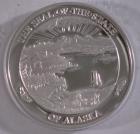1994 Alaska Medallion - The Grizzly


Current List Price $275.00
Please CONTACT US for availability information.
The 2004 Grizzly Bear, one ounce silver proof, had a total mintage of 6,800 pieces.
What medallion design could better depict Alaska than the Grizzly Bear? Due to the severity of the Alaskan winters these bears may spend as many as seven months hibernating in their dens...
Brown Bears are found throughout much of Alaska. Alaska contains over 98% of the U.S. population of Brown Bears and over 70% of the North American population. Formerly it was thought that Brown and Grizzly were two separate species. They are now classified as the same species (Ursus arctos). In popular usage, "Brown" refers to coastal bears and "Grizzly" refers to inland bears.
The Brown Bear resembles its close relative the Black Bear but it is usually larger, has a prominent shoulder hump and has longer and straighter claws. Brown Bears range in color from dark brown to blond. Bears gain weight rapidly during late summer and fall just prior to denning. At this point, most mature males weigh between 400 and 900 lbs. (182 - 409 kg.). Extremely large bears have weighted as much as 1,4000 lbs. (636 kg.). Females weigh 1/2 to 3/4 as much.
Brown Bears are omnivorous. Common foods included berries, grasses, fish and roots of many plants. They are capable predators of newborn moose and caribou and can also kill and consume healthy adults of these species. The Alaskan Brown Bears enter dens and sleep through the winter in a state of dormancy or hibernation. Brown Bears enter dens and sleep though the winter in a state of dormancy or hibernation. Brown Bears should be treated with respect and should be observed from a distance of at least 100 years.
Silver Trivia:
When Joseph Nicephore Niepce created the first photographic image obtained through a camera-like device in 1813, it was silver nitrate that made it possible.
